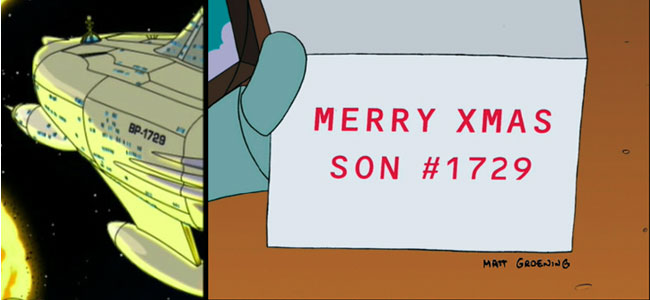第  个出租车数
个出租车数  是可以用
是可以用  种方式表示为正立方数之和的最小数。这些数字的名字来源于 哈代-拉马努金数
种方式表示为正立方数之和的最小数。这些数字的名字来源于 哈代-拉马努金数
这与 G. H. 哈代 (Hofstadter 1989, Kanigel 1991, Snow 1993) 讲述的关于拉马努金的故事有关。
1729 的这个性质在 2005 年的电影证明中被安东尼·霍普金斯扮演的角色罗伯特(有时是精神失常的数学家)提及。它也是动画电视剧飞出个未来第二季 DVD 2ACV02 集(Greenwald;左图)中出现的 Nimbus BP-1729 宇宙飞船的名称的一部分,以及机器人角色本德的序列号,如圣诞贺卡在圣诞故事一集中所描绘的那样(第 2 卷 DVD,Georgoulias et al. 2004;右图)。
然而,早在 1657 年,F. de Bessy (Berndt and Bhargava 1993, Guy 1994) 就已经知道了这个性质。Leech (1957) 发现
Rosenstiel et al. (1991) 最近发现
Wilson (1999) 发现
因此,前几个出租车数是 2, 1729, 87539319, 6963472309248, 48988659276962496, ... (OEIS A011541)。
第六个出租车数是
(Calude et al. 2003, Hollerbach 2008)。
Hardy 和 Wright (1979 年定理 412) 表明,这种和的数量可以任意大,但是,根据威尔逊的结果更新 Guy (1994) 的结果,对于六个或更多相等的和,最小的例子仍然未知。
Sloane 定义了一种略有不同的出租车数类型,即可以用两种或多种方式表示为两个立方和的数字,其中前几个是 1729, 4104, 13832, 20683, 32832, 39312, 40033, 46683, 64232, ... (OEIS A001235)。
另请参见
Cabtaxi 数,
丢番图方程——3 次幂,
哈代-拉马努金数,
出租车度量
使用 探索
参考文献
Berndt, B. C. and Bhargava, S. "Ramanujan--For Lowbrows." Am. Math. Monthly 100, 645-656, 1993.Butler, B. "Ramanujan Numbers and the Taxicab Problem." http://www.durangobill.com/Ramanujan.html.Calude,C. S.; Calude, E.; and Dinneen, M. J. "What Is the Value of Taxicab(6)?" J. Uni. Comp. Sci. 9, 1196-1203, 2003. http://www.cs.auckland.ac.nz/~cristian/taxicab.pdf.Georgoulias, T.; Greenwald, S. J.; and Wichterich, M. "Futurama  : Mathematics in the Year 3000." Math Horizons, 12-15, Apr. 2004.Greenwald, S. "Dr. Sarah's Futurama
: Mathematics in the Year 3000." Math Horizons, 12-15, Apr. 2004.Greenwald, S. "Dr. Sarah's Futurama  --Mathematics in the Year 3000." http://www.mathsci.appstate.edu/~sjg/futurama/.Guy, R. K. "Sums of Like Powers. Euler's Conjecture." §D1 in Unsolved Problems in Number Theory, 2nd ed. New York: Springer-Verlag, pp. 139-144, 1994.Hardy, G. H. Ramanujan: Twelve Lectures on Subjects Suggested by His Life and Work, 3rd ed. New York: Chelsea, pp. 12 and 68, 1999.Hardy, G. H. and Wright, E. M. An Introduction to the Theory of Numbers, 5th ed. Oxford, England: Clarendon Press, 1979.Hofstadter, D. R. Gödel, Escher, Bach: An Eternal Golden Braid. New York: Vintage Books, p. 564, 1989.Hollerbach, U. "The Sixth Taxicab Number Is 24153319581254312065344." Mar. 8, 2008. http://listserv.nodak.edu/cgi-bin/wa.exe?A2=ind0803&L=nmbrthry&T=0&F=&S=&P=1059.Kanigel, R. The Man Who Knew Infinity: A Life of the Genius Ramanujan. New York: Washington Square Press, p. 312, 1991.Leech, J. "Some Solutions of Diophantine Equations." Proc. Cambridge Phil. Soc. 53, 778-780, 1957.Meyrignac, J. "The Taxicab Problem." http://euler.free.fr/taxicab.htm.Plouffe, S. "Taxicab Numbers." http://pi.lacim.uqam.ca/eng/problem_en.html.Rosenstiel, E.; Dardis, J. A.; and Rosenstiel, C. R. "The Four Least Solutions in Distinct Positive Integers of the Diophantine Equation
--Mathematics in the Year 3000." http://www.mathsci.appstate.edu/~sjg/futurama/.Guy, R. K. "Sums of Like Powers. Euler's Conjecture." §D1 in Unsolved Problems in Number Theory, 2nd ed. New York: Springer-Verlag, pp. 139-144, 1994.Hardy, G. H. Ramanujan: Twelve Lectures on Subjects Suggested by His Life and Work, 3rd ed. New York: Chelsea, pp. 12 and 68, 1999.Hardy, G. H. and Wright, E. M. An Introduction to the Theory of Numbers, 5th ed. Oxford, England: Clarendon Press, 1979.Hofstadter, D. R. Gödel, Escher, Bach: An Eternal Golden Braid. New York: Vintage Books, p. 564, 1989.Hollerbach, U. "The Sixth Taxicab Number Is 24153319581254312065344." Mar. 8, 2008. http://listserv.nodak.edu/cgi-bin/wa.exe?A2=ind0803&L=nmbrthry&T=0&F=&S=&P=1059.Kanigel, R. The Man Who Knew Infinity: A Life of the Genius Ramanujan. New York: Washington Square Press, p. 312, 1991.Leech, J. "Some Solutions of Diophantine Equations." Proc. Cambridge Phil. Soc. 53, 778-780, 1957.Meyrignac, J. "The Taxicab Problem." http://euler.free.fr/taxicab.htm.Plouffe, S. "Taxicab Numbers." http://pi.lacim.uqam.ca/eng/problem_en.html.Rosenstiel, E.; Dardis, J. A.; and Rosenstiel, C. R. "The Four Least Solutions in Distinct Positive Integers of the Diophantine Equation  ." Bull. Inst. Math. Appl. 27, 155-157, 1991.Silverman, J. H. "Taxicabs and Sums of Two Cubes." Amer. Math. Monthly 100, 331-340, 1993.Sloane, N. J. A. Sequences A001235 and A011541 in "The On-Line Encyclopedia of Integer Sequences."Snow, C. P. Foreword to A Mathematician's Apology, reprinted with a foreword by C. P. Snow (by G. H. Hardy). New York: Cambridge University Press, p. 37, 1993.Wilson, D. W. "The Fifth Taxicab Number is 48988659276962496." J. Integer Sequences 2, #99.1.9, 1999.Wooley, T. D. "Sums of Two Cubes." Internat. Math. Res. Not. No. 4, 181-184, 1995.
." Bull. Inst. Math. Appl. 27, 155-157, 1991.Silverman, J. H. "Taxicabs and Sums of Two Cubes." Amer. Math. Monthly 100, 331-340, 1993.Sloane, N. J. A. Sequences A001235 and A011541 in "The On-Line Encyclopedia of Integer Sequences."Snow, C. P. Foreword to A Mathematician's Apology, reprinted with a foreword by C. P. Snow (by G. H. Hardy). New York: Cambridge University Press, p. 37, 1993.Wilson, D. W. "The Fifth Taxicab Number is 48988659276962496." J. Integer Sequences 2, #99.1.9, 1999.Wooley, T. D. "Sums of Two Cubes." Internat. Math. Res. Not. No. 4, 181-184, 1995.在 上引用
出租车数
请引用为
Weisstein, Eric W. "出租车数。" 来自 —— 资源。 https://mathworld.net.cn/TaxicabNumber.html
主题分类
个出租车数
是可以用
种方式表示为正立方数之和的最小数。这些数字的名字来源于 哈代-拉马努金数
